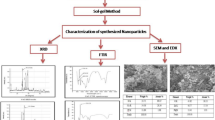Abstract
Zirconium diboride (ZrB2) nanoparticles were synthesized by sol-gel method using zirconium n-propoxide (Zr(OPr)4), boric acid (H3BO3), and sucrose (C12H22O11). Additionally, acetylacetone (acac) was used as chemical modifier in a neutral condition to stabilize Zr(OPr)4 which hydrolyzes easily. Here, C12H22O11 was used since it can be completely decomposed to carbon. Thus, carbon might be accounted precisely for the carbothermal reduction reaction. A single phase ZrB2 without residual ZrO2 was obtained with a molar ratio of B/Zr = 2.3 for the starting materials at 1,550 °C and the average grain size of ZrB2 nanoparticles was ca. 50 nm. The photomicrograph revealed a spherical round shape morphology of the ZrB2 nanoparticles with an uniform size distribution. On the other hand, in the case of either B/Zr (mol.) = 2.0 or pyrolyzing temperature below 1,550 °C for B/Zr (mol.) = 2.3, there existed both m-ZrO2 and t-ZrO2 phases besides ZrB2.






Similar content being viewed by others
References
Cutler RA (1991) In: Schneider SJ (ed.) Ceramics and glasses: engineered materials handbook, ASM International, Materials Park, OH, vol. 4: 787–803
Levine SR, Opila EJ, Halbig MC, Kiser JD, Singh M, Salem JA (2002) J Eur Ceram Soc 22:2757–2767
Murata Y (1970) US Patent 3, 487:594
Norasetthekul S, Eubank PT, Bradley WL, Bozkurt B, Stucker B (1999) J Mater Sci 34:1261–1270
Mroz C (1995) Am Ceram Bull 76:164–165
Munir ZA (1988) Am Ceram Soc Bull 67:342–349
Mishra SK, Das S, Ramchandrarao P (2002) J Mater Res 17:2809–2814
Campbell IE, Sherwood EM (1967) Wiley, New York, 353
Setoudeh N, Welham NJ (2006) J Alloys Comp 420:225–228
Erdem CH, Amurlu HE, Maglia F (2009) J Eur Ceram Soc 29:1501–1506
Akgün B (2008) M. Sc. Thesis, Middle East Technical University, Ankara
Zhang HJ, Li FL (2008) J Sol-Gel Sci Technol 45:205–211
Yan YJ, Huang ZR, Liu XJ, Jiang DL (2007) J Sol-Gel Sci Technol 44:81–85
Cao SL, Yao N, Yeung KL (2008) J Sol-Gel Sci Technol 46:323–333
Yan YJ, Huang ZR, Dong SM, Jiang DL (2006) J Am Ceram Soc 89(11):3585–3588
Xie YL, Thomas H, Sanders Jr, Robert F (2008) J Am Ceram Soc 91(5): 1469–1474
Press H, Berger LM, Szulzewsky K (1996) Carbon 34:109–119
Yi G, Sayer M (1996) J Sol-Gel Sci Technol 6:65–74
Sanchez C, Livage J, Henry M, Babonneau F (1988) J Non-Cryst Solids 100:65–76
Zhan ZQ, Zeng HC (1999) J Non-Cryst Solids 243:26–38
Jain A, Sacks MD, Wang CA, Middlemas M, Cheng Z (2003) Ceram Eng Sci Proc 24(A):41–49
Padmavathi N, Ray KK, Subrahmanyam J, Ghosal P, Kumari S (2009) J Mater Sci 44:3255–3264
Yun SM, Palanivelu K, Kim YH, Kang KH, Lee YS (2008) J Ind Eng Chem 14:667–671
Fahrenholtz WG (2005) J Am Ceram Soc 88 (12):3509–3512
Acknowledgments
The authors appreciate the financial support from the National Science Foundation of China (NSFC50974007); the Scientific Research Starting Foundation for Returned Overseas Chinese Scholars, Ministry of Education; the Start-Up Fund for High-End Returned Overseas Talents, Ministry of Human Resources and Social Security, China and the Lab-Installation Foundation of Beihang University for New Teachers.
Author information
Authors and Affiliations
Corresponding author
Rights and permissions
About this article
Cite this article
Li, R., Zhang, Y., Lou, H. et al. Synthesis of ZrB2 nanoparticles by sol-gel method. J Sol-Gel Sci Technol 58, 580–585 (2011). https://doi.org/10.1007/s10971-011-2430-y
Received:
Accepted:
Published:
Issue Date:
DOI: https://doi.org/10.1007/s10971-011-2430-y




